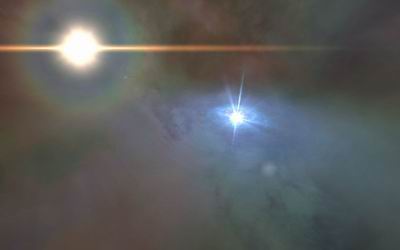(单词翻译:单击)
听力文本
This is Scientific American — 60-Second Science. I'm Christopher Intagliata.
On March 11, 1437, Korean royal astronomers noticed something out of the ordinary in the night sky. "There was a brand new star they'd never seen before, between two of the well-known stars in the tail of Scorpius. That star was only seen for 14 days and then it disappeared and was never seen again."
Michael Shara, an astronomer at the American Museum of Natural History in New York. He's spent more than two decades puzzling over this star that winked at astronomers nearly 600 years ago. "It's a many-sided jigsaw puzzle and I won't say we've filled in all the pieces, but at least I think we've got the corners and the boundaries pretty much in place now."
What he and his colleagues have determined is this: the "disappearing star" the Korean astronomers spotted was in fact a massive explosion produced by a special type of binary star system, known as a 'cataclysmic variable.'
The system consists of two stars. One's a white dwarf—"the corpse of something that used to be a star in the distant past. It what's left after the star died." And its companion is a hydrogen-rich star, pretty much like our sun.

"The white dwarf's gravity is so powerful it can suck hydrogen off of that companion. So in essence it's cannibalizing its companion hydrogen-rich star. That hydrogen flows into a ring around the white dwarf, and then every few months or few years the ring builds up, becomes more and more massive and collapses down onto the white dwarf. That gives rise to what we call dwarf nova eruptions."
But every couple of hundred thousand years, those dwarf eruptions are punctuated by much bigger bangs, as more and more hydrogen builds up. "You blow up as a gigantic hydrogen bomb, that's a thermonuclear event. And that classical nova is what happened in 1437 to this star."
Shara's team located the cosmic remains of that huge explosion. And they were able to determine that the nova of 1437—and smaller dwarf nova eruptions photographed in that same square of sky in the 1930s and '40s—were actually hiccups of light from the same binary star...in different phases of its life cycle.
"And hence dwarf novae and old novae are the same things. Just like butterflies and caterpillars are the same things." The study is in the journal Nature.
Shara says 50 of these novalike fireworks explode every year in the Milky Way...illuminating the galaxy, and perhaps, our understanding of the evolution of stars.
Thanks for listening for Scientific American — 60-Second Science Science. I'm Christopher Intagliata.
参考译文
这里是科学美国人——60秒科学。我是克里斯托弗·因塔利亚塔。
1437年3月11日,朝鲜王室天文学家在观测夜空时,注意到了不同寻常的现象。“他们在天蝎座尾端两颗著名星星之间发现了一颗从未见过的新星。那颗新星只出现了14天便消失了,之后再也没有人见过它。”
迈克尔·沙雷是位于纽约的美国自然历史博物馆的天文学家。他花了二十多年的时间,仔细研究这颗曾于600年前在天文学家眼前闪过的星星。“它就像个多边拼图,我不敢说我们已经拼好了所有板块,但我认为至少我们已经把各个边角都拼得非常到位了。”
他和同事已经确定:那颗朝鲜天文学家发现的“消失的星星”,实际上是由一种被称为“激变变星”的特殊双星系统产生的大爆炸。
这一系统由两颗恒星组成。一颗是白矮星,即“远古时期某个恒星的尸体”。它是恒星衰亡后的残留物。另一颗是与我们的太阳非常像的富含氢的恒星。
“白矮星的引力非常强,以致于会吸取同伴的氢元素。从本质上说,白矮星在吸食富含氢的恒星同伴。那些被吸来的氢形成围绕白矮星的环带,然后每隔几个月或几年的时间,环带就会聚集起来,变得越来越大,直至坍落到白矮星上。并因此导致矮新星爆发。”
但每隔几十万年,随着聚集的氢越来越多,这些矮新星爆发会被更强大的爆炸打断。“就像引爆了一个巨型氢弹,这是热核爆炸事件。而朝鲜发现的那颗新星就是1437年矮新星上发生的氢气爆炸。”
沙雷的团队找到了那次巨大爆炸的宇宙残骸。而且他们能够确定,1437年的新星和上世纪三四十年代天文学家在同一片天空中拍下的较小矮新星爆发,竟然同属在不同生命阶段的同一个双子星系中。
“因此,矮新星就是旧新星。就像蝴蝶和毛毛虫是同一种生物一样。”这项研究结果发表在《自然》期刊上。
沙雷表示,每年银河系都有50多个类新星爆发照亮银河系……或许,它也在照亮我们对恒星进化史的认知。
谢谢大家收听科学美国人——60秒科学。我是克里斯托弗·因塔利亚塔。
译文为可可英语翻译,未经授权请勿转载!
重点讲解
重点讲解:
1. out of the ordinary 不寻常的;非凡的;特殊的;
例句:The boy's knowledge was out of the ordinary.
这个男孩懂得的知识非比寻常。
2. puzzle over 对…苦苦思索;因…大伤脑筋;
例句:In rehearsing Shakespeare, I puzzle over the complexities of his verse and prose.
在排演莎士比亚的戏剧时,其中诗句和散文的复杂让我大伤脑筋。
3. consist of 由…组成;由…构成;
例句:A healthy diet should consist of wholefood.
健康饮食应由全天然食物构成。
4. blow up 引爆;(使)炸毁;(使)爆炸;
例句:Their boat blew up as they slept.
他们睡觉的时候船爆炸了。


